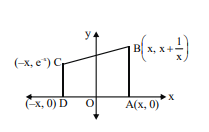Q.
If the maximum area of trapezium $ABCD$ formed by points $A ( x , 0), B \left( x , x +\frac{1}{ x }\right), C \left(- x , e ^{- x }\right)$, $D (- x , 0)$ is $S$, where $0< x \leq 1$, then find the value of $[ eS ]$.
[Note : [ $k$ ] denote the greatest integer less than or equal to $k$ and ' $e$ ' is napier constant.]
Application of Derivatives
Solution:
Area of trapezium $\Delta=1+ x ^2+ xe ^{- x }$
and $\frac{ d \Delta}{ dx } \geq 0$ when $x \in(0,1]$
$\therefore S =\Delta_{\max }=2+\frac{1}{ e }$, when $x =1$
$\therefore[ es ]=6 . $
